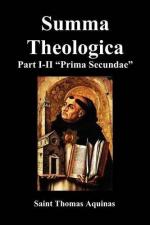I answer that, As stated above (A. 1; Q. 99, AA. 3, 4), the ceremonial precepts are those which refer to the worship of God. Now the Divine worship is twofold: internal, and external. For since man is composed of soul and body, each of these should be applied to the worship of God; the soul by an interior worship; the body by an outward worship: hence it is written (Ps. 83:3): “My heart and my flesh have rejoiced in the living God.” And as the body is ordained to God through the soul, so the outward worship is ordained to the internal worship. Now interior worship consists in the soul being united to God by the intellect and affections. Wherefore according to the various ways in which the intellect and affections of the man who worships God are rightly united to God, his external actions are applied in various ways to the Divine worship.
For in the state of future bliss, the human intellect will gaze on the Divine Truth in Itself. Wherefore the external worship will not consist in anything figurative, but solely in the praise of God, proceeding from the inward knowledge and affection, according to Isa. 51:3: “Joy and gladness shall be found therein, thanksgiving and the voice of praise.”
But in the present state of life, we are unable to gaze on the Divine Truth in Itself, and we need the ray of Divine light to shine upon us under the form of certain sensible figures, as Dionysius states (Coel. Hier. i); in various ways, however, according to the various states of human knowledge. For under the Old Law, neither was the Divine Truth manifest in Itself, nor was the way leading to that manifestation as yet opened out, as the Apostle declares (Heb. 9:8). Hence the external worship of the Old Law needed to be figurative not only of the future truth to be manifested in our heavenly country, but also of Christ, Who is the way leading to that heavenly manifestation. But under the New Law this way is already revealed: and therefore it needs no longer to be foreshadowed as something future, but to be brought to our minds as something past or present: and the truth of the glory to come, which is not yet revealed, alone needs to be foreshadowed. This is what the Apostle says (Heb. 11:1): “The Law has [Vulg.: ‘having’] a shadow of the good things to come, not the very image of the things”: for a shadow is less than an image; so that the image belongs to the New Law, but the shadow to the Old.
Reply Obj. 1: The things of God are not to be revealed to man except in proportion to his capacity: else he would be in danger of downfall, were he to despise what he cannot grasp. Hence it was more beneficial that the Divine mysteries should be revealed to uncultured people under a veil of figures, that thus they might know them at least implicitly by using those figures to the honor of God.
Reply Obj. 2: Just as human reason fails to grasp poetical expressions on account of their being lacking in truth, so does it fail to grasp Divine things perfectly, on account of the sublimity of the truth they contain: and therefore in both cases there is need of signs by means of sensible figures.




